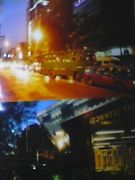|
|
|
|
コメント(9)
バーンラックについて↓の記事をみつけました。バーンラックミュジアムがあったとは知らなかったなーしかし。川に沿って流れてきたかのように、いろいろな人種が住みついて、文化の交流はここから始まったわけです(な?)^^ 外国人のコミュニテイーのほとんどが元々この地域にあったのです。
このコミュもそういう場所であったらいいな^^
「The Bangrak Museum, collocated with the Folk Museum in Soi Charoen Krung 43, records the history of early Bangkok in the Bangrak district. The district got its name from the huge Rak tree trunk sunken in one of the canals in the area.
Several interesting aspects of Bangkok's history (1800s – 1900s) are covered in the Bangrak Museum:
The early foreign communities and their influence in the area,The growth of trade and financial activities,The roads and canals in the area and the people who contributed to the construction.
Over two centuries, Bangkok grew from a fortified city to a commercial port and onto an urban industrialized metropolis.
The Portuguese were the first Europeans to arrive in Thailand in the Ayutthaya days. Their embassy is the oldest in Bangkok, located in Charoen Krung, the oldest road. Bangkok grew quickly as a trading port with traders from Portugal, Holland, Britain, India and China.
Most of the foreign communities were in Bangrak. As Bangkok grew out of the walled city, it became a cultural melting pot for Thais, Chinese, Mon, Lao, Indians, Europeans and Americans.
When the Bowring Treaty was signed in 1855 in the reign of King Rama IV, trade in Bangkok opened up. Foreigners were granted the right to trade directly, hitherto a royal monopoly. Trading companies were setup together banks, warehouses and factories.
With the foreign traders came the missionaries. In the prevailing religious tolerance, churches, temples, mosques, schools, convents and hospitals were built with land grants. Retail shops grew to support the trading activities. The first printing press in Thai started in Bangrak.
As trade grew, so did the need for transportation. Roads and canals expanded rapidly, with trams and the first railway, the Bangkok - Paknam line. Canals played a vital role in bringing rice and other produce from the provinces to Bangkok.
The Bangrak Museum has an interesting record of the origins of the early roads and canals.」
(http://tour-bangkok-legacies.com/bangrak-museum.html より抜粋)
このコミュもそういう場所であったらいいな^^
「The Bangrak Museum, collocated with the Folk Museum in Soi Charoen Krung 43, records the history of early Bangkok in the Bangrak district. The district got its name from the huge Rak tree trunk sunken in one of the canals in the area.
Several interesting aspects of Bangkok's history (1800s – 1900s) are covered in the Bangrak Museum:
The early foreign communities and their influence in the area,The growth of trade and financial activities,The roads and canals in the area and the people who contributed to the construction.
Over two centuries, Bangkok grew from a fortified city to a commercial port and onto an urban industrialized metropolis.
The Portuguese were the first Europeans to arrive in Thailand in the Ayutthaya days. Their embassy is the oldest in Bangkok, located in Charoen Krung, the oldest road. Bangkok grew quickly as a trading port with traders from Portugal, Holland, Britain, India and China.
Most of the foreign communities were in Bangrak. As Bangkok grew out of the walled city, it became a cultural melting pot for Thais, Chinese, Mon, Lao, Indians, Europeans and Americans.
When the Bowring Treaty was signed in 1855 in the reign of King Rama IV, trade in Bangkok opened up. Foreigners were granted the right to trade directly, hitherto a royal monopoly. Trading companies were setup together banks, warehouses and factories.
With the foreign traders came the missionaries. In the prevailing religious tolerance, churches, temples, mosques, schools, convents and hospitals were built with land grants. Retail shops grew to support the trading activities. The first printing press in Thai started in Bangrak.
As trade grew, so did the need for transportation. Roads and canals expanded rapidly, with trams and the first railway, the Bangkok - Paknam line. Canals played a vital role in bringing rice and other produce from the provinces to Bangkok.
The Bangrak Museum has an interesting record of the origins of the early roads and canals.」
(http://tour-bangkok-legacies.com/bangrak-museum.html より抜粋)
Kokoさん> ロビンソンの向かいですか〜 ロビンソン辺りですれ違ったりしてたかもしれませんね^^ ロビンソン周辺に美味しいKUAI+ JAP(クワイジャップ=ヌードルスープです。白い太い麺に、レバーや煮込み肉などを載せた汁そば)の屋台があるのですが(夜しかやってない)、食べたことあるかな〜
色々おいしいものありますね〜バーンラックは^^ タイの昔からのお菓子やさんとかも^^
Thonburiさん>はじめまして。よろしくです^^
シルバーの問屋さんが多くなったな〜って2月帰ったとき思いました。 ThonburiさんはThonburi辺りに住んでいるのでしょうか?^^ また色々現地のお話を聞かせてください^^ バーンラックの名物、Khaaw khaa+muu+(豚足ご飯)は食べたことありますか〜 とても美味しいので、今度バーンラックに寄る時に是非!
たけこさん、色々な石鹸があるんですね〜^^ (ドリアンはいやだな^^)バーンラックは今度ご案内しますよ^^v 私が通っていた小学校とか(あんま興味ないかっ 笑)
色々おいしいものありますね〜バーンラックは^^ タイの昔からのお菓子やさんとかも^^
Thonburiさん>はじめまして。よろしくです^^
シルバーの問屋さんが多くなったな〜って2月帰ったとき思いました。 ThonburiさんはThonburi辺りに住んでいるのでしょうか?^^ また色々現地のお話を聞かせてください^^ バーンラックの名物、Khaaw khaa+muu+(豚足ご飯)は食べたことありますか〜 とても美味しいので、今度バーンラックに寄る時に是非!
たけこさん、色々な石鹸があるんですね〜^^ (ドリアンはいやだな^^)バーンラックは今度ご案内しますよ^^v 私が通っていた小学校とか(あんま興味ないかっ 笑)
- mixiユーザー
- ログインしてコメントしよう!
|
|
|
|
DEK BANGRAK 更新情報
-
最新のイベント
-
まだ何もありません
-
-
最新のアンケート
-
まだ何もありません
-
























